MERCEDES-BENZ SPRINTER 2014 MY14 Operator’s Manual
Manufacturer: MERCEDES-BENZ, Model Year: 2014, Model line: SPRINTER, Model: MERCEDES-BENZ SPRINTER 2014Pages: 338, PDF Size: 6.78 MB
Page 21 of 338
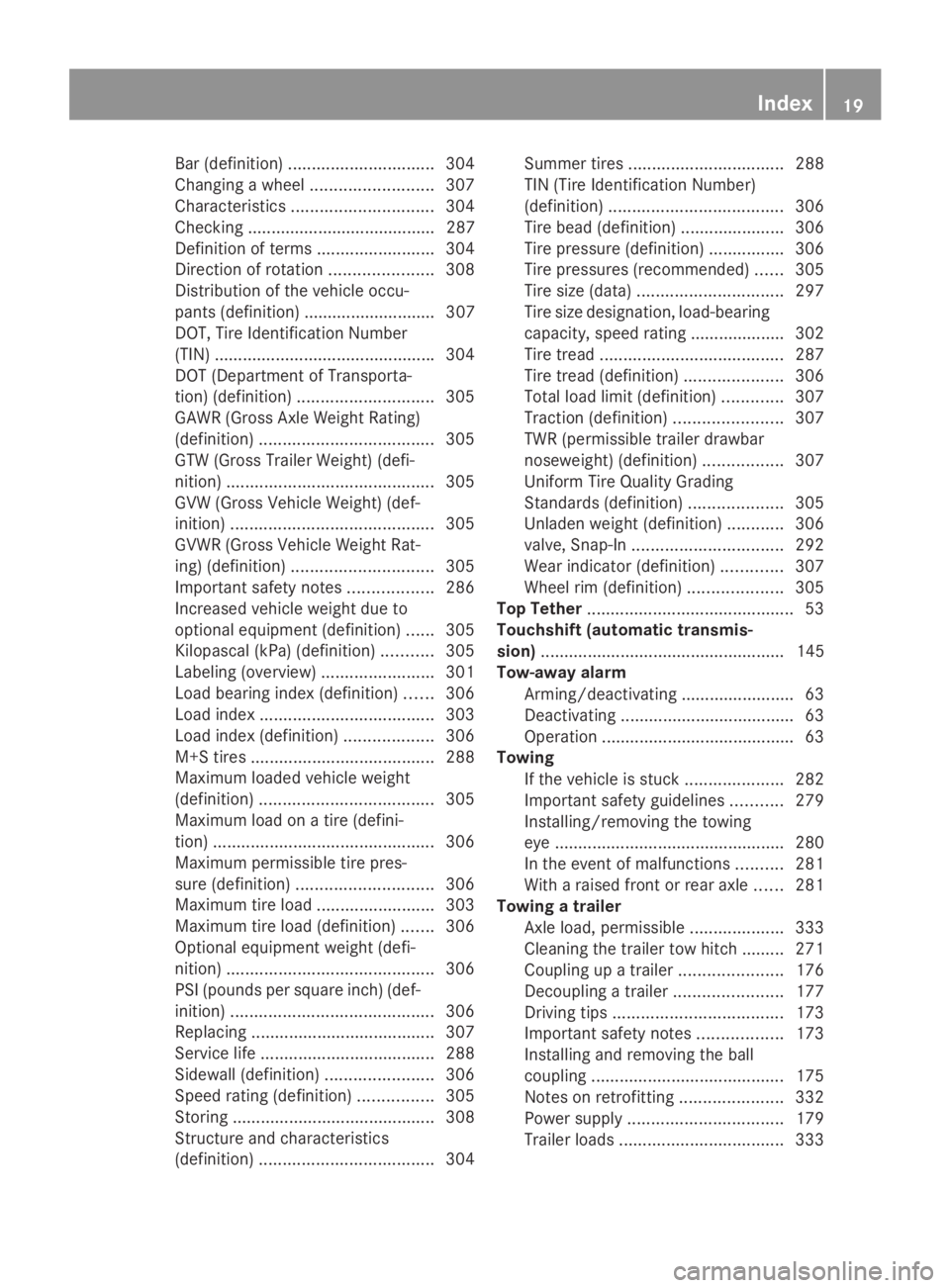
Bar (definition)
............................... 304
Changing a wheel .......................... 307
Characteristics .............................. 304
Checking ........................................ 287
Definition of terms .........................304
Direction of rotatio n...................... 308
Distribution of the vehicle occu-
pants (definition) ............................ 307
DOT, Tire Identification Number
(TIN) .............................................. .304
DOT (Department of Transporta-
tion) (definition) ............................. 305
GAWR (Gross Axle Weight Rating)
(definition) ..................................... 305
GTW (Gross Trailer Weight) (defi-
nition) ............................................ 305
GVW (Gross Vehicle Weight) (def-
inition) ........................................... 305
GVWR (Gross Vehicle Weight Rat-
ing) (definition) .............................. 305
Important safety notes ..................286
Increased vehicle weight due to
optional equipment (definition) ......305
Kilopascal (kPa) (definition) ...........305
Labeling (overview )........................ 301
Load bearing index (definition) ......306
Load index ..................................... 303
Load index (definition) ...................306
M+S tires ....................................... 288
Maximum loaded vehicle weight
(definition) ..................................... 305
Maximum load on a tire (defini-
tion) ............................................... 306
Maximum permissible tire pres-
sure (definition) ............................. 306
Maximum tire loa d......................... 303
Maximum tire load (definition) .......306
Optional equipment weight (defi-
nition) ............................................ 306
PSI (pounds per square inch) (def-
inition) ........................................... 306
Replacing ....................................... 307
Service life ..................................... 288
Sidewall (definition) .......................306
Speed rating (definition) ................305
Storing ........................................... 308
Structure and characteristics
(definition) ..................................... 304Summer tires
................................. 288
TIN (Tire Identification Number)
(definition) ..................................... 306
Tire bead (definition) ......................306
Tire pressure (definition) ................306
Tire pressures (recommended )...... 305
Tire size (data) ............................... 297
Tire size designation, load-bearing
capacity, speed rating .................... 302
Tire tread ....................................... 287
Tire tread (definition) .....................306
Total load limit (definition) .............307
Traction (definition) .......................307
TWR (permissible trailer drawbar
noseweight) (definition) .................307
Uniform Tire Quality Grading
Standards (definition) ....................305
Unladen weight (definition) ............306
valve, Snap-In ................................ 292
Wear indicator (definition) .............307
Wheel rim (definition) ....................305
Top Tether ............................................ 53
Touchshift (automatic transmis-
sion) .................................................... 145
Tow-away alarm Arming/deactivating ........................63
Deactivating .................................... .63
Operation ........................................ .63
Towing
If the vehicle is stuck .....................282
Important safety guidelines ...........279
Installing/removing the towing
eye ................................................ .280
In the event of malfunctions ..........281
With a raised front or rear axle ......281
Towing a trailer
Axle load, permissible ....................333
Cleaning the trailer tow hitch ......... 271
Coupling up a trailer ......................176
Decoupling a trailer .......................177
Driving tips .................................... 173
Important safety notes ..................173
Installing and removing the ball
coupling ......................................... 175
Notes on retrofitting ......................332
Power supply ................................. 179
Trailer loads ................................... 333 Index
19
Page 22 of 338
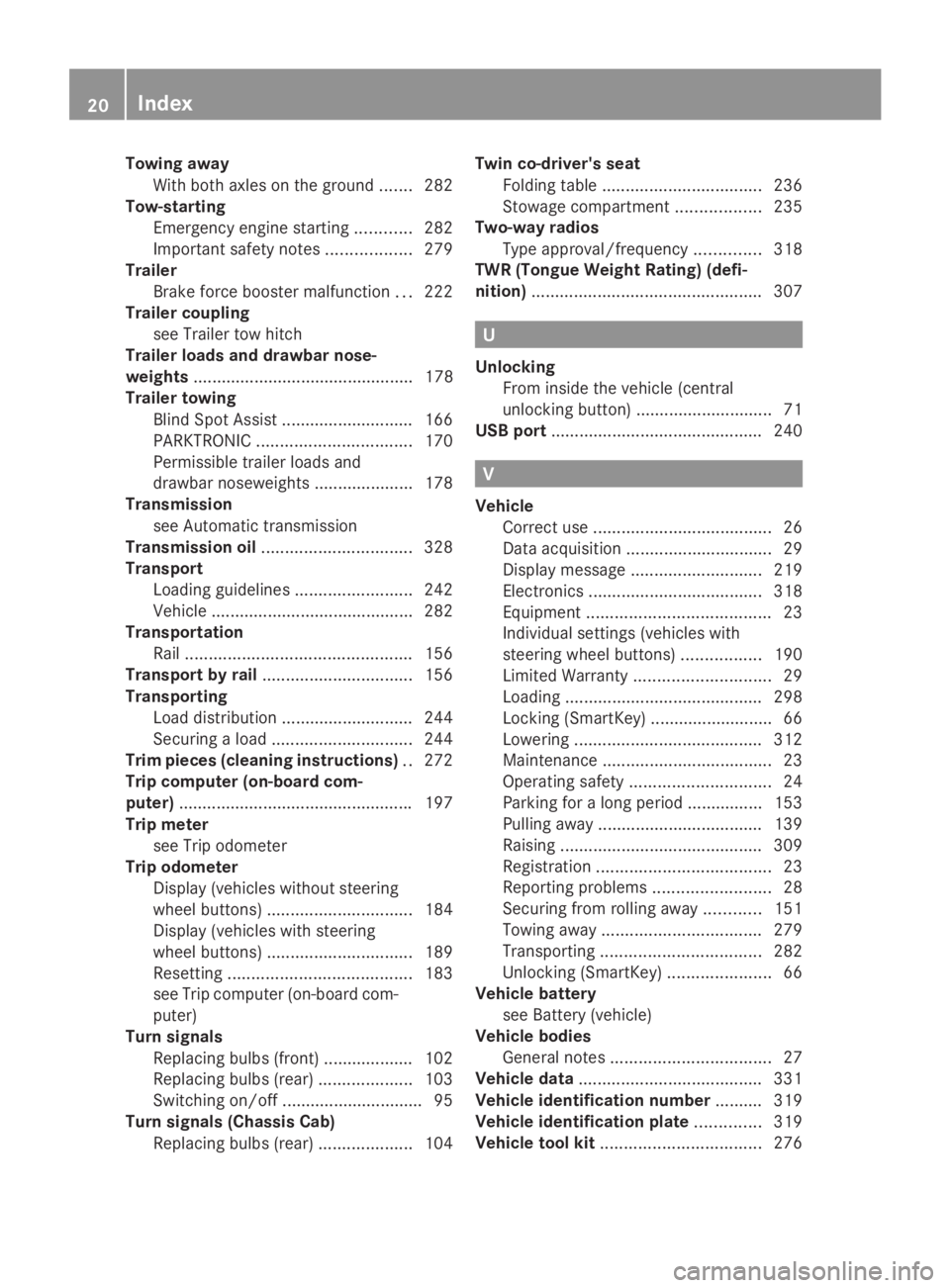
Towing away
With both axles on the ground .......282
Tow-starting
Emergency engine starting ............282
Important safety notes ..................279
Trailer
Brake force booster malfunction ...222
Trailer coupling
see Trailer tow hitch
Trailer loads and drawbar nose-
weights ............................................... 178
Trailer towing Blind Spot Assist ............................ 166
PARKTRONIC ................................. 170
Permissible trailer loads and
drawbar noseweights .....................178
Transmission
see Automatic transmission
Transmission oil ................................ 328
Transport Loading guidelines .........................242
Vehicle .......................................... .282
Transportation
Rail ................................................ 156
Transport by rail ................................ 156
Transporting Load distribution ............................ 244
Securing a loa d.............................. 244
Trim pieces (cleaning instructions) ..272
Trip computer (on-board com-
puter) ................................................. .197
Trip meter see Trip odometer
Trip odometer
Display (vehicles without steering
wheel buttons) ............................... 184
Display (vehicles with steering
wheel buttons) ............................... 189
Resetting ....................................... 183
see Trip computer (on-board com-
puter)
Turn signals
Replacing bulbs (front) ................... 102
Replacing bulbs (rear) ....................103
Switching on/off .............................. 95
Turn signals (Chassis Cab)
Replacing bulbs (rear) ....................104Twin co-driver's seat
Folding table .................................. 236
Stowage compartment ..................235
Two-way radios
Type approval/frequency ..............318
TWR (Tongue Weight Rating) (defi-
nition) ................................................. 307 U
Unlocking From inside the vehicle (central
unlocking button) ............................. 71
USB port ............................................. 240 V
Vehicle Correct use ...................................... 26
Data acquisition ............................... 29
Display message ............................ 219
Electronics ..................................... 318
Equipment ....................................... 23
Individual settings (vehicles with
steering wheel buttons) .................190
Limited Warranty ............................. 29
Loading .......................................... 298
Locking (SmartKey) .......................... 66
Lowering ........................................ 312
Maintenance .................................... 23
Operating safety .............................. 24
Parking for a long period ................ 153
Pulling away ................................... 139
Raising ........................................... 309
Registration ..................................... 23
Reporting problems .........................28
Securing from rolling away ............151
Towing away .................................. 279
Transporting .................................. 282
Unlocking (SmartKey) ......................66
Vehicle battery
see Battery (vehicle)
Vehicle bodies
General notes .................................. 27
Vehicle data ....................................... 331
Vehicle identification number .......... 319
Vehicle identification plate ..............319
Vehicle tool kit .................................. 27620
Index
Page 23 of 338
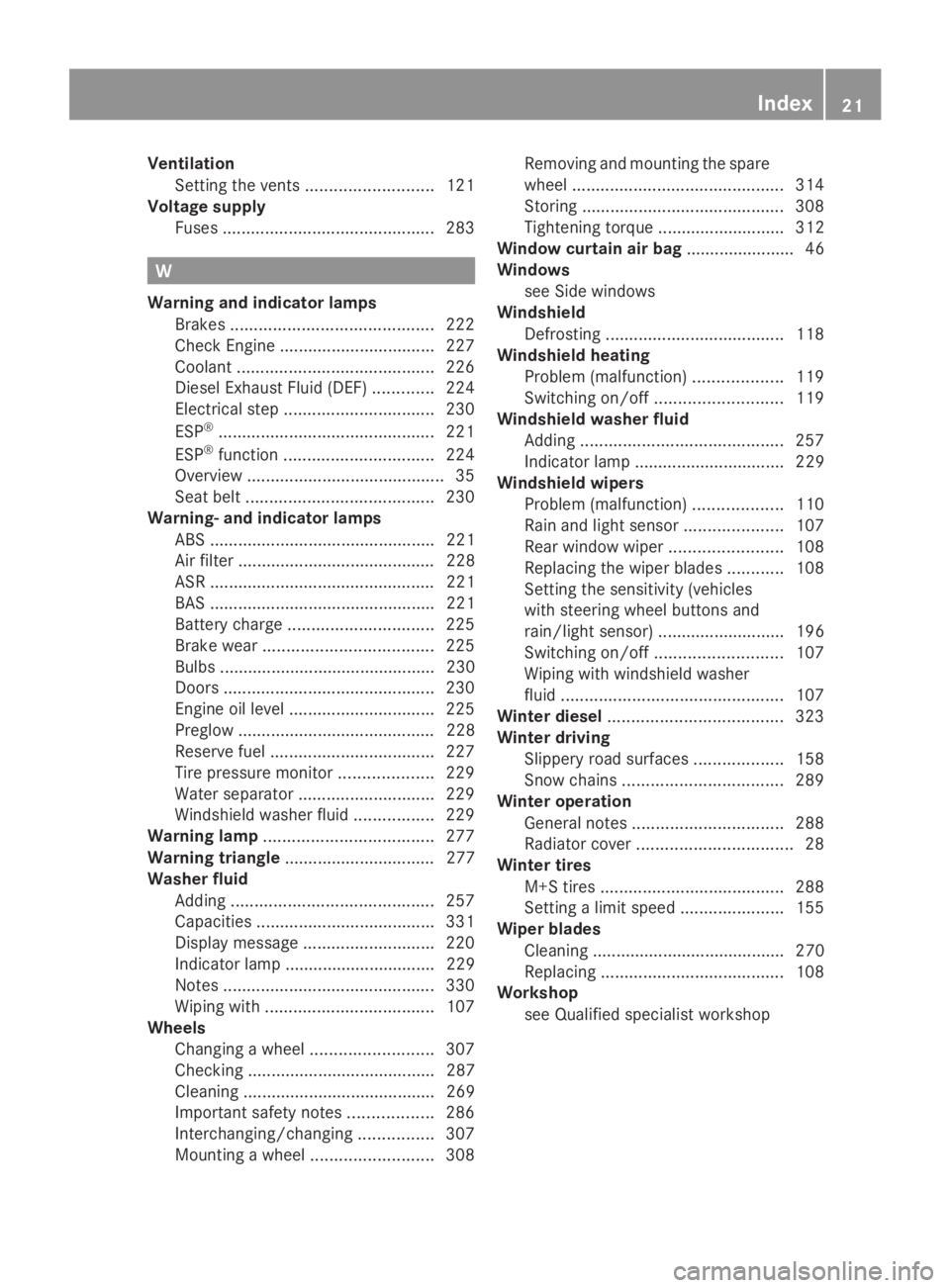
Ventilation
Setting the vents ........................... 121
Voltage supply
Fuses ............................................. 283W
Warning and indicator lamps Brakes ........................................... 222
Check Engine ................................. 227
Coolant .......................................... 226
Diesel Exhaust Fluid (DEF) .............224
Electrical step ................................ 230
ESP ®
.............................................. 221
ESP ®
function ................................ 224
Overview .......................................... 35
Seat belt ........................................ 230
Warning- and indicator lamps
ABS ................................................ 221
Air filter .......................................... 228
ASR ................................................ 221
BAS ................................................ 221
Battery charge ............................... 225
Brake wear .................................... 225
Bulbs .............................................. 230
Doors ............................................. 230
Engine oil level ............................... 225
Preglow .......................................... 228
Reserve fuel ................................... 227
Tire pressure monitor ....................229
Water separator ............................. 229
Windshield washer fluid .................229
Warning lamp .................................... 277
Warning triangle ................................ 277
Washer fluid Adding ........................................... 257
Capacities ...................................... 331
Display message ............................ 220
Indicator lamp ................................ 229
Notes ............................................. 330
Wiping with .................................... 107
Wheels
Changing a wheel .......................... 307
Checking ........................................ 287
Cleaning ......................................... 269
Important safety notes ..................286
Interchanging/changing ................307
Mounting a wheel .......................... 308Removing and mounting the spare
wheel
............................................. 314
Storing ........................................... 308
Tightening torque ........................... 312
Window curtain air bag ....................... 46
Windows see Side windows
Windshield
Defrosting ...................................... 118
Windshield heating
Problem (malfunction) ...................119
Switching on/off ........................... 119
Windshield washer fluid
Adding ........................................... 257
Indicator lamp ................................ 229
Windshield wipers
Problem (malfunction) ...................110
Rain and light sensor .....................107
Rear window wiper ........................108
Replacing the wiper blades ............108
Setting the sensitivity (vehicles
with steering wheel buttons and
rain/light sensor) ........................... 196
Switching on/off ........................... 107
Wiping with windshield washer
fluid ............................................... 107
Winter diesel ..................................... 323
Winter driving Slippery road surfaces ...................158
Snow chains .................................. 289
Winter operation
General notes ................................ 288
Radiator cover ................................. 28
Winter tires
M+S tires ....................................... 288
Setting a limit speed ......................155
Wiper blades
Cleaning ......................................... 270
Replacing ....................................... 108
Workshop
see Qualified specialist workshop Index
21
Page 24 of 338
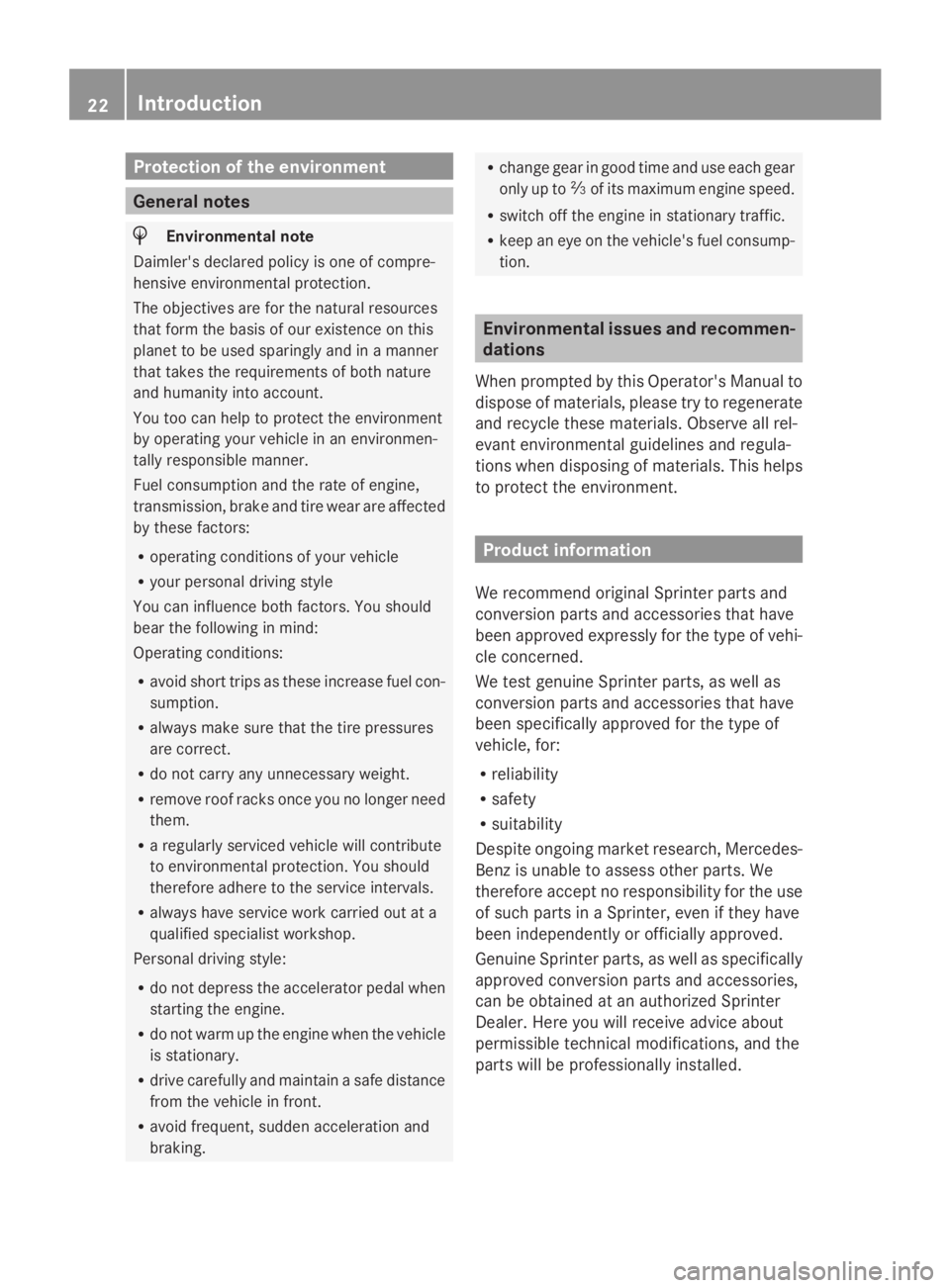
Protection of the environment
General notes
H
Environmental note
Daimler's declared policy is one of compre-
hensive environmental protection.
The objectives are for the natural resources
that form the basis of our existence on this
planet to be used sparingly and in a manner
that takes the requirements of both nature
and humanity into account.
You too can help to protect the environment
by operating your vehicle in an environmen-
tally responsible manner.
Fuel consumption and the rate of engine,
transmission, brake and tire wear are affected
by these factors:
R operating conditions of your vehicle
R your personal driving style
You can influence both factors. You should
bear the following in mind:
Operating conditions:
R avoid short trips as these increase fuel con-
sumption.
R always make sure that the tire pressures
are correct.
R do not carry any unnecessary weight.
R remove roof racks once you no longer need
them.
R a regularly serviced vehicle will contribute
to environmental protection. You should
therefore adhere to the service intervals.
R always have service work carried out at a
qualified specialist workshop.
Personal driving style:
R do not depress the accelerator pedal when
starting the engine.
R do not warm up the engine when the vehicle
is stationary.
R drive carefully and maintain a safe distance
from the vehicle in front.
R avoid frequent, sudden acceleration and
braking. R
change gear in good time and use each gear
only up to 00C3of its maximum engine speed.
R switch off the engine in stationary traffic.
R keep an eye on the vehicle's fuel consump-
tion. Environmental issues and recommen-
dations
When prompted by this Operator's Manual to
dispose of materials, please try to regenerate
and recycle these materials. Observe all rel-
evant environmental guidelines and regula-
tions when disposing of materials. This helps
to protect the environment. Product information
We recommend original Sprinter parts and
conversion parts and accessories that have
been approved expressly for the type of vehi-
cle concerned.
We test genuine Sprinter parts, as well as
conversion parts and accessories that have
been specifically approved for the type of
vehicle, for:
R reliability
R safety
R suitability
Despite ongoing market research, Mercedes-
Benz is unable to assess other parts. We
therefore accept no responsibility for the use
of such parts in a Sprinter, even if they have
been independently or officially approved.
Genuine Sprinter parts, as well as specifically
approved conversion parts and accessories,
can be obtained at an authorized Sprinter
Dealer. Here you will receive advice about
permissible technical modifications, and the
parts will be professionally installed. 22
Introduction
Page 25 of 338
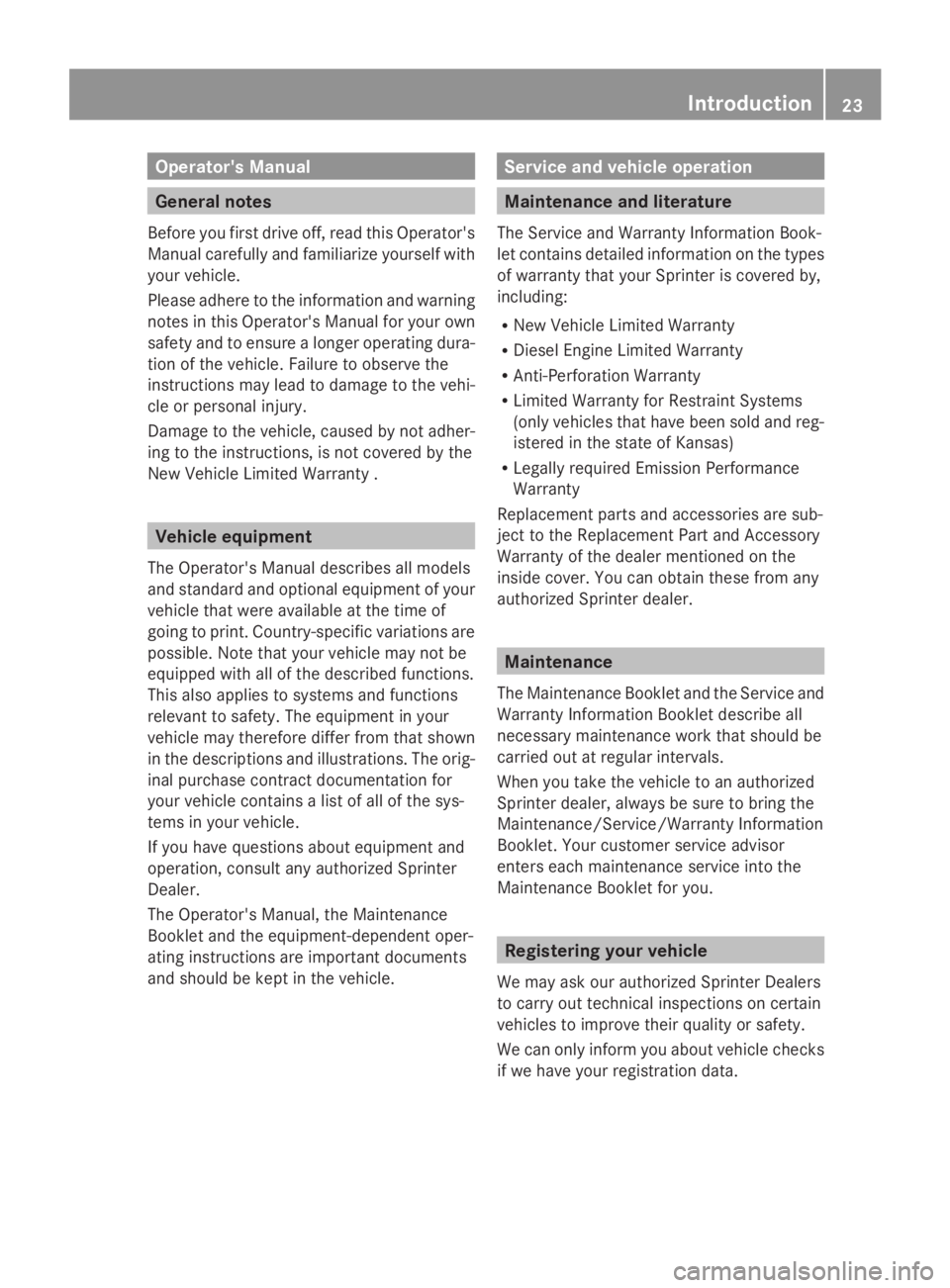
Operator's Manual
General notes
Before you first drive off, read this Operator's
Manual carefully and familiarize yourself with
your vehicle.
Please adhere to the information and warning
notes in this Operator's Manual for your own
safety and to ensure a longer operating dura-
tion of the vehicle. Failure to observe the
instructions may lead to damage to the vehi-
cle or personal injury.
Damage to the vehicle, caused by not adher-
ing to the instructions, is not covered by the
New Vehicle Limited Warranty . Vehicle equipment
The Operator's Manual describes all models
and standard and optional equipment of your
vehicle that were available at the time of
going to print. Country-specific variations are
possible. Note that your vehicle may not be
equipped with all of the described functions.
This also applies to systems and functions
relevant to safety. The equipment in your
vehicle may therefore differ from that shown
in the descriptions and illustrations. The orig-
inal purchase contract documentation for
your vehicle contains a list of all of the sys-
tems in your vehicle.
If you have questions about equipment and
operation, consult any authorized Sprinter
Dealer.
The Operator's Manual, the Maintenance
Booklet and the equipment-dependent oper-
ating instructions are important documents
and should be kept in the vehicle. Service and vehicle operation
Maintenance and literature
The Service and Warranty Information Book-
let contains detailed information on the types
of warranty that your Sprinter is covered by,
including:
R New Vehicle Limited Warranty
R Diesel Engine Limited Warranty
R Anti-Perforation Warranty
R Limited Warranty for Restraint Systems
(only vehicles that have been sold and reg-
istered in the state of Kansas)
R Legally required Emission Performance
Warranty
Replacement parts and accessories are sub-
ject to the Replacement Part and Accessory
Warranty of the dealer mentioned on the
inside cover. You can obtain these from any
authorized Sprinter dealer. Maintenance
The Maintenance Booklet and the Service and
Warranty Information Booklet describe all
necessary maintenance work that should be
carried out at regular intervals.
When you take the vehicle to an authorized
Sprinter dealer, always be sure to bring the
Maintenance/Service/Warranty Information
Booklet. Your customer service advisor
enters each maintenance service into the
Maintenance Booklet for you. Registering your vehicle
We may ask our authorized Sprinter Dealers
to carry out technical inspections on certain
vehicles to improve their quality or safety.
We can only inform you about vehicle checks
if we have your registration data. Introduction
23 Z
Page 26 of 338
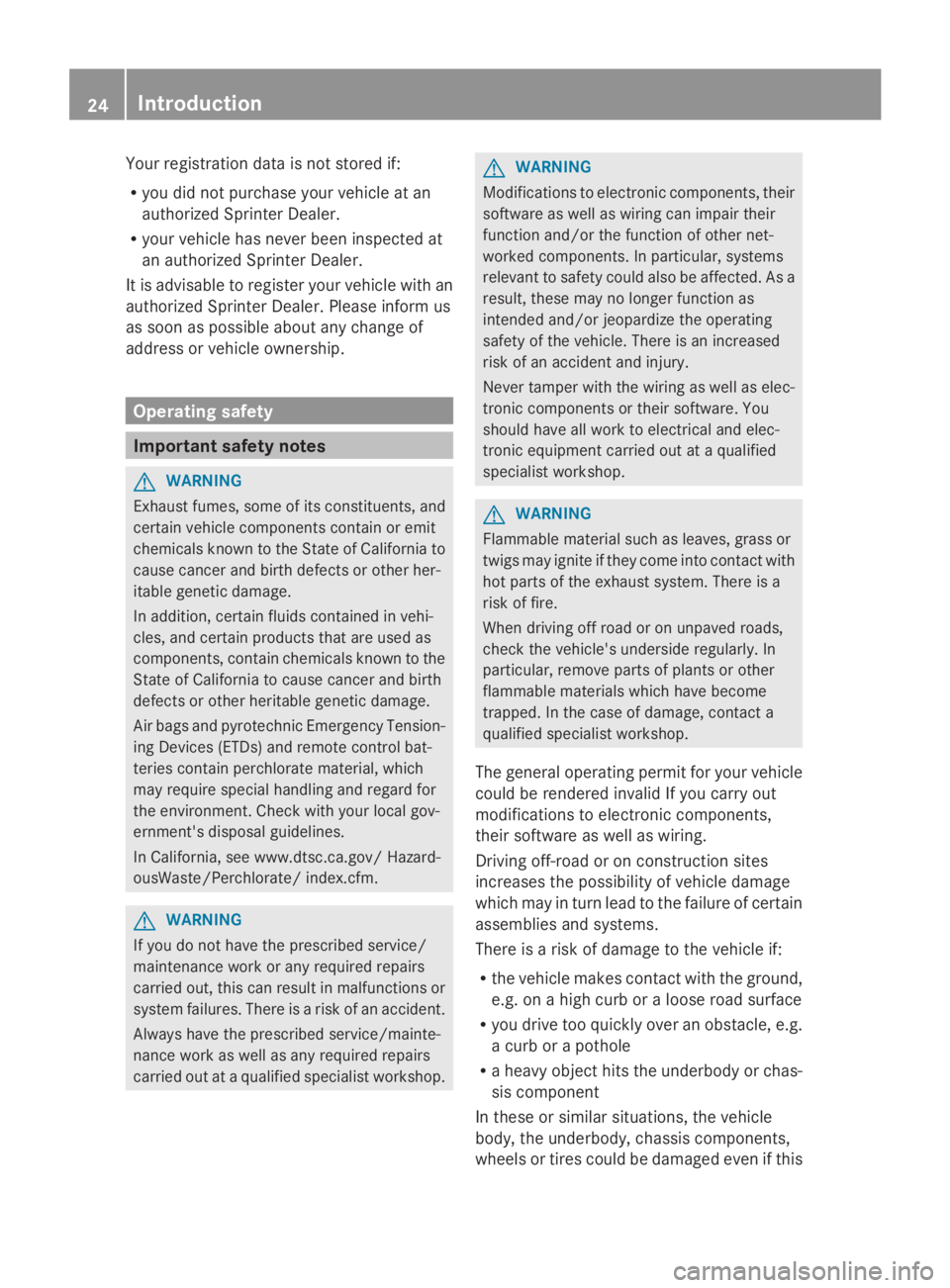
Your registration data is not stored if:
R you did not purchase your vehicle at an
authorized Sprinter Dealer.
R your vehicle has never been inspected at
an authorized Sprinter Dealer.
It is advisable to register your vehicle with an
authorized Sprinter Dealer. Please inform us
as soon as possible about any change of
address or vehicle ownership. Operating safety
Important safety notes
G
WARNING
Exhaust fumes, some of its constituents, and
certain vehicle components contain or emit
chemicals known to the State of California to
cause cancer and birth defects or other her-
itable genetic damage.
In addition, certain fluids contained in vehi-
cles, and certain products that are used as
components, contain chemicals known to the
State of California to cause cancer and birth
defects or other heritable genetic damage.
Air bags and pyrotechnic Emergency Tension-
ing Devices (ETDs) and remote control bat-
teries contain perchlorate material, which
may require special handling and regard for
the environment. Check with your local gov-
ernment's disposal guidelines.
In California, see www.dtsc.ca.gov/ Hazard-
ousWaste/Perchlorate/ index.cfm. G
WARNING
If you do not have the prescribed service/
maintenance work or any required repairs
carried out, this can result in malfunctions or
system failures. There is a risk of an accident.
Always have the prescribed service/mainte-
nance work as well as any required repairs
carried out at a qualified specialist workshop. G
WARNING
Modifications to electronic components, their
software as well as wiring can impair their
function and/or the function of other net-
worked components. In particular, systems
relevant to safety could also be affected. As a
result, these may no longer function as
intended and/or jeopardize the operating
safety of the vehicle. There is an increased
risk of an accident and injury.
Never tamper with the wiring as well as elec-
tronic components or their software. You
should have all work to electrical and elec-
tronic equipment carried out at a qualified
specialist workshop. G
WARNING
Flammable material such as leaves, grass or
twigs may ignite if they come into contact with
hot parts of the exhaust system. There is a
risk of fire.
When driving off road or on unpaved roads,
check the vehicle's underside regularly. In
particular, remove parts of plants or other
flammable materials which have become
trapped. In the case of damage, contact a
qualified specialist workshop.
The general operating permit for your vehicle
could be rendered invalid If you carry out
modifications to electronic components,
their software as well as wiring.
Driving off-road or on construction sites
increases the possibility of vehicle damage
which may in turn lead to the failure of certain
assemblies and systems.
There is a risk of damage to the vehicle if:
R the vehicle makes contact with the ground,
e.g. on a high curb or a loose road surface
R you drive too quickly over an obstacle, e.g.
a curb or a pothole
R a heavy object hits the underbody or chas-
sis component
In these or similar situations, the vehicle
body, the underbody, chassis components,
wheels or tires could be damaged even if this 24
Introduction
Page 27 of 338
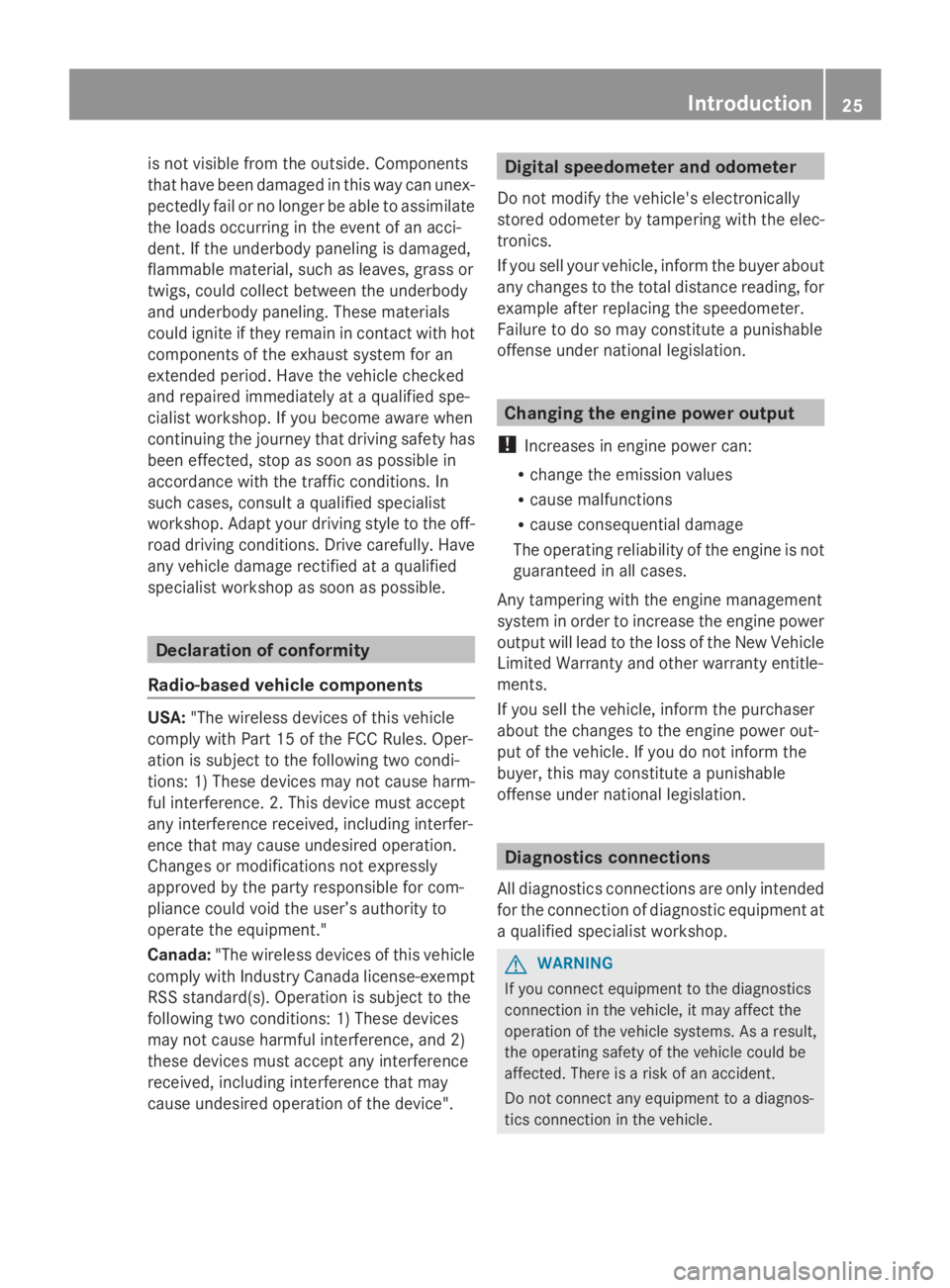
is not visible from the outside. Components
that have been damaged in this way can unex-
pectedly fail or no longer be able to assimilate
the loads occurring in the event of an acci-
dent. If the underbody paneling is damaged,
flammable material, such as leaves, grass or
twigs, could collect between the underbody
and underbody paneling. These materials
could ignite if they remain in contact with hot
components of the exhaust system for an
extended period. Have the vehicle checked
and repaired immediately at a qualified spe-
cialist workshop. If you become aware when
continuing the journey that driving safety has
been effected, stop as soon as possible in
accordance with the traffic conditions. In
such cases, consult a qualified specialist
workshop. Adapt your driving style to the off-
road driving conditions. Drive carefully. Have
any vehicle damage rectified at a qualified
specialist workshop as soon as possible. Declaration of conformity
Radio-based vehicle components USA:
"The wireless devices of this vehicle
comply with Part 15 of the FCC Rules. Oper-
ation is subject to the following two condi-
tions: 1) These devices may not cause harm-
ful interference. 2. This device must accept
any interference received, including interfer-
ence that may cause undesired operation.
Changes or modifications not expressly
approved by the party responsible for com-
pliance could void the user’s authority to
operate the equipment."
Canada: "The wireless devices of this vehicle
comply with Industry Canada license-exempt
RSS standard(s). Operation is subject to the
following two conditions: 1) These devices
may not cause harmful interference, and 2)
these devices must accept any interference
received, including interference that may
cause undesired operation of the device". Digital speedometer and odometer
Do not modify the vehicle's electronically
stored odometer by tampering with the elec-
tronics.
If you sell your vehicle, inform the buyer about
any changes to the total distance reading, for
example after replacing the speedometer.
Failure to do so may constitute a punishable
offense under national legislation. Changing the engine power output
! Increases in engine power can:
R change the emission values
R cause malfunctions
R cause consequential damage
The operating reliability of the engine is not
guaranteed in all cases.
Any tampering with the engine management
system in order to increase the engine power
output will lead to the loss of the New Vehicle
Limited Warranty and other warranty entitle-
ments.
If you sell the vehicle, inform the purchaser
about the changes to the engine power out-
put of the vehicle. If you do not inform the
buyer, this may constitute a punishable
offense under national legislation. Diagnostics connections
All diagnostics connections are only intended
for the connection of diagnostic equipment at
a qualified specialist workshop. G
WARNING
If you connect equipment to the diagnostics
connection in the vehicle, it may affect the
operation of the vehicle systems. As a result,
the operating safety of the vehicle could be
affected. There is a risk of an accident.
Do not connect any equipment to a diagnos-
tics connection in the vehicle. Introduction
25 Z
Page 28 of 338
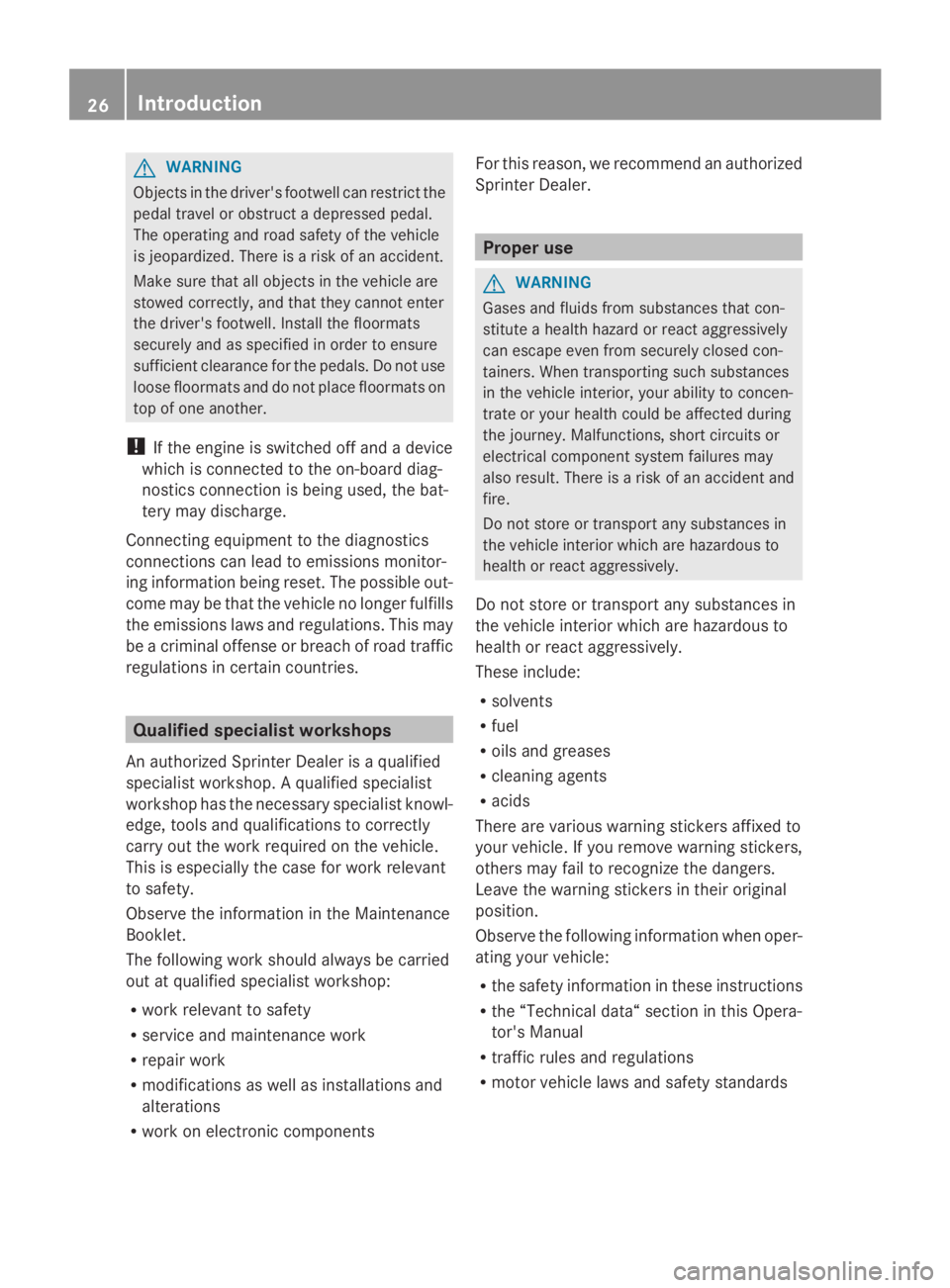
G
WARNING
Objects in the driver's footwell can restrict the
pedal travel or obstruct a depressed pedal.
The operating and road safety of the vehicle
is jeopardized. There is a risk of an accident.
Make sure that all objects in the vehicle are
stowed correctly, and that they cannot enter
the driver's footwell. Install the floormats
securely and as specified in order to ensure
sufficient clearance for the pedals. Do not use
loose floormats and do not place floormats on
top of one another.
! If the engine is switched off and a device
which is connected to the on-board diag-
nostics connection is being used, the bat-
tery may discharge.
Connecting equipment to the diagnostics
connections can lead to emissions monitor-
ing information being reset. The possible out-
come may be that the vehicle no longer fulfills
the emissions laws and regulations. This may
be a criminal offense or breach of road traffic
regulations in certain countries. Qualified specialist workshops
An authorized Sprinter Dealer is a qualified
specialist workshop. A qualified specialist
workshop has the necessary specialist knowl-
edge, tools and qualifications to correctly
carry out the work required on the vehicle.
This is especially the case for work relevant
to safety.
Observe the information in the Maintenance
Booklet.
The following work should always be carried
out at qualified specialist workshop:
R work relevant to safety
R service and maintenance work
R repair work
R modifications as well as installations and
alterations
R work on electronic components For this reason, we recommend an authorized
Sprinter Dealer. Proper use
G
WARNING
Gases and fluids from substances that con-
stitute a health hazard or react aggressively
can escape even from securely closed con-
tainers. When transporting such substances
in the vehicle interior, your ability to concen-
trate or your health could be affected during
the journey. Malfunctions, short circuits or
electrical component system failures may
also result. There is a risk of an accident and
fire.
Do not store or transport any substances in
the vehicle interior which are hazardous to
health or react aggressively.
Do not store or transport any substances in
the vehicle interior which are hazardous to
health or react aggressively.
These include:
R solvents
R fuel
R oils and greases
R cleaning agents
R acids
There are various warning stickers affixed to
your vehicle. If you remove warning stickers,
others may fail to recognize the dangers.
Leave the warning stickers in their original
position.
Observe the following information when oper-
ating your vehicle:
R the safety information in these instructions
R the “Technical data“ section in this Opera-
tor's Manual
R traffic rules and regulations
R motor vehicle laws and safety standards 26
Introduction
Page 29 of 338
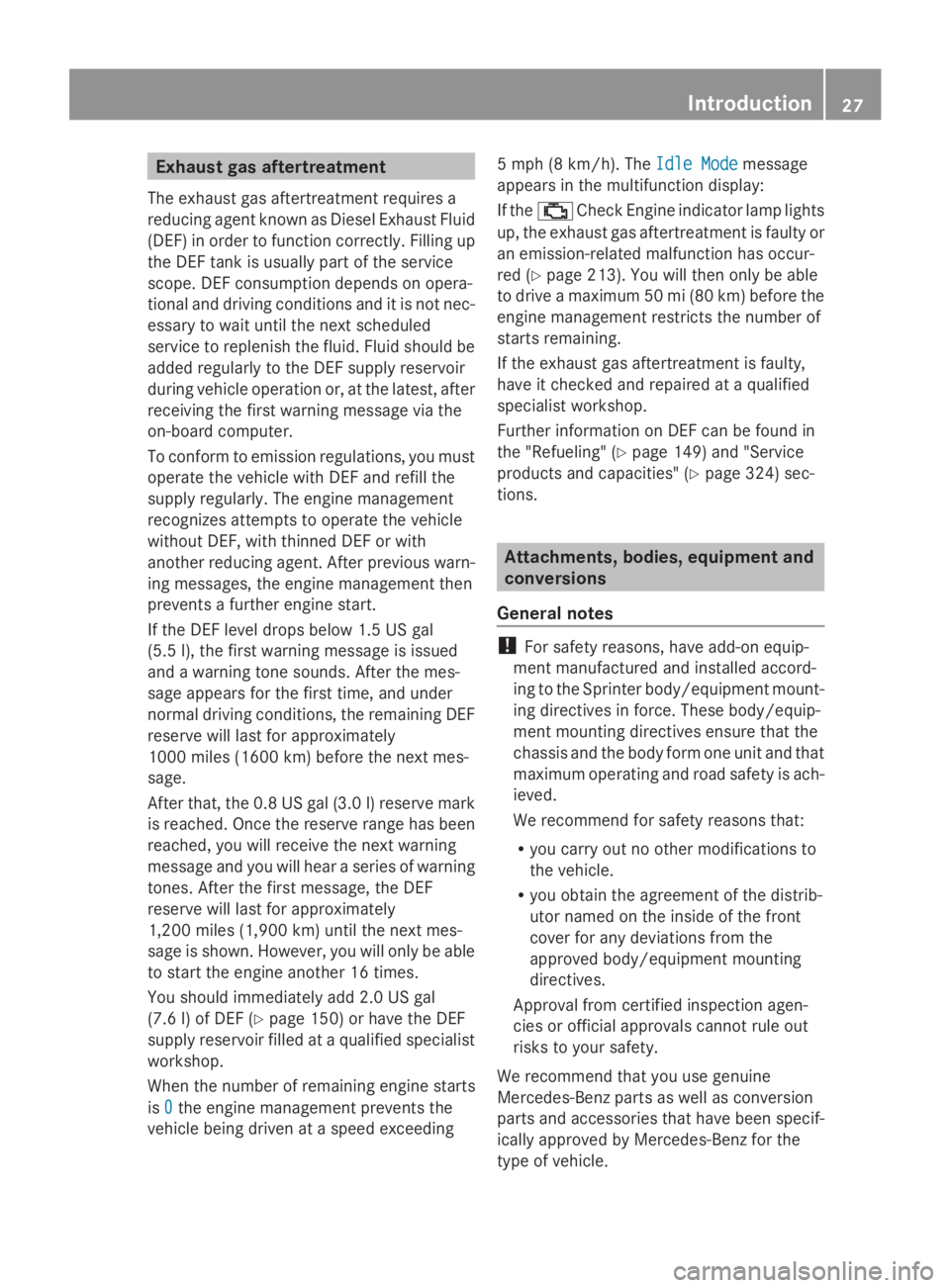
Exhaust gas aftertreatment
The exhaust gas aftertreatment requires a
reducing agent known as Diesel Exhaust Fluid
(DEF) in order to function correctly. Filling up
the DEF tank is usually part of the service
scope. DEF consumption depends on opera-
tional and driving conditions and it is not nec-
essary to wait until the next scheduled
service to replenish the fluid. Fluid should be
added regularly to the DEF supply reservoir
during vehicle operation or, at the latest, after
receiving the first warning message via the
on-board computer.
To conform to emission regulations, you must
operate the vehicle with DEF and refill the
supply regularly. The engine management
recognizes attempts to operate the vehicle
without DEF, with thinned DEF or with
another reducing agent. After previous warn-
ing messages, the engine management then
prevents a further engine start.
If the DEF level drops below 1.5 US gal
(5.5 l), the first warning message is issued
and a warning tone sounds. After the mes-
sage appears for the first time, and under
normal driving conditions, the remaining DEF
reserve will last for approximately
1000 miles (1600 km) before the next mes-
sage.
After that, the 0.8 US gal (3.0 l)reserve mark
is reached. Once the reserve range has been
reached, you will receive the next warning
message and you will hear a series of warning
tones. After the first message, the DEF
reserve will last for approximately
1,200 miles (1,900 km) until the next mes-
sage is shown. However, you will only be able
to start the engine another 16 times.
You should immediately add 2.0 US gal
(7.6 l) of DEF (Y page 150) or have the DEF
supply reservoir filled at a qualified specialist
workshop.
When the number of remaining engine starts
is 0
0 the engine management prevents the
vehicle being driven at a speed exceeding 5 mph (8 km/h). The
Idle Mode Idle Modemessage
appears in the multifunction display:
If the 00B9 Check Engine indicator lamp lights
up, the exhaust gas aftertreatment is faulty or
an emission-related malfunction has occur-
red (Y page 213). You will then only be able
to drive a maximum 50 mi (80 km) before the
engine management restricts the number of
starts remaining.
If the exhaust gas aftertreatment is faulty,
have it checked and repaired at a qualified
specialist workshop.
Further information on DEF can be found in
the "Refueling" (Y page 149) and "Service
products and capacities" (Y page 324) sec-
tions. Attachments, bodies, equipment and
conversions
General notes !
For safety reasons, have add-on equip-
ment manufactured and installed accord-
ing to the Sprinter body/equipment mount-
ing directives in force. These body/equip-
ment mounting directives ensure that the
chassis and the body form one unit and that
maximum operating and road safety is ach-
ieved.
We recommend for safety reasons that:
R you carry out no other modifications to
the vehicle.
R you obtain the agreement of the distrib-
utor named on the inside of the front
cover for any deviations from the
approved body/equipment mounting
directives.
Approval from certified inspection agen-
cies or official approvals cannot rule out
risks to your safety.
We recommend that you use genuine
Mercedes-Benz parts as well as conversion
parts and accessories that have been specif-
ically approved by Mercedes-Benz for the
type of vehicle. Introduction
27 Z
Page 30 of 338
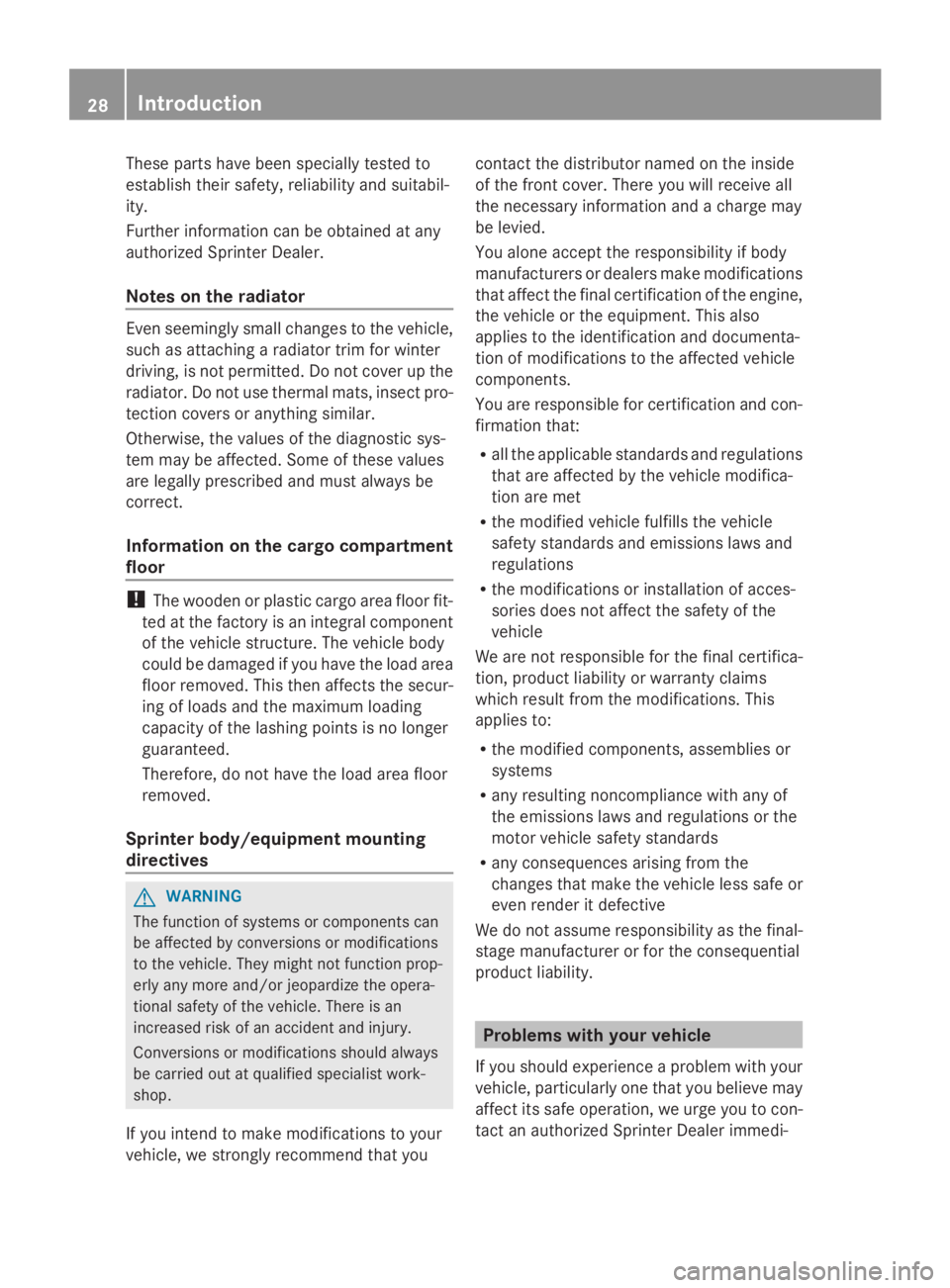
These parts have been specially tested to
establish their safety, reliability and suitabil-
ity.
Further information can be obtained at any
authorized Sprinter Dealer.
Notes on the radiator Even seemingly small changes to the vehicle,
such as attaching a radiator trim for winter
driving, is not permitted. Do not cover up the
radiator. Do not use thermal mats, insect pro-
tection covers or anything similar.
Otherwise, the values of the diagnostic sys-
tem may be affected. Some of these values
are legally prescribed and must always be
correct.
Information on the cargo compartment
floor !
The wooden or plastic cargo area floor fit-
ted at the factory is an integral component
of the vehicle structure. The vehicle body
could be damaged if you have the load area
floor removed. This then affects the secur-
ing of loads and the maximum loading
capacity of the lashing points is no longer
guaranteed.
Therefore, do not have the load area floor
removed.
Sprinter body/equipment mounting
directives G
WARNING
The function of systems or components can
be affected by conversions or modifications
to the vehicle. They might not function prop-
erly any more and/or jeopardize the opera-
tional safety of the vehicle. There is an
increased risk of an accident and injury.
Conversions or modifications should always
be carried out at qualified specialist work-
shop.
If you intend to make modifications to your
vehicle, we strongly recommend that you contact the distributor named on the inside
of the front cover. There you will receive all
the necessary information and a charge may
be levied.
You alone accept the responsibility if body
manufacturers or dealers make modifications
that affect the final certification of the engine,
the vehicle or the equipment. This also
applies to the identification and documenta-
tion of modifications to the affected vehicle
components.
You are responsible for certification and con-
firmation that:
R all the applicable standards and regulations
that are affected by the vehicle modifica-
tion are met
R the modified vehicle fulfills the vehicle
safety standards and emissions laws and
regulations
R the modifications or installation of acces-
sories does not affect the safety of the
vehicle
We are not responsible for the final certifica-
tion, product liability or warranty claims
which result from the modifications. This
applies to:
R the modified components, assemblies or
systems
R any resulting noncompliance with any of
the emissions laws and regulations or the
motor vehicle safety standards
R any consequences arising from the
changes that make the vehicle less safe or
even render it defective
We do not assume responsibility as the final-
stage manufacturer or for the consequential
product liability. Problems with your vehicle
If you should experience a problem with your
vehicle, particularly one that you believe may
affect its safe operation, we urge you to con-
tact an authorized Sprinter Dealer immedi- 28
Introduction